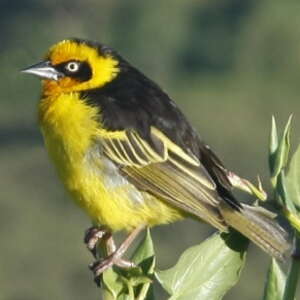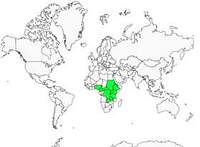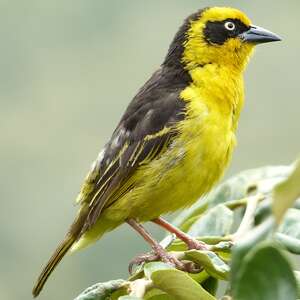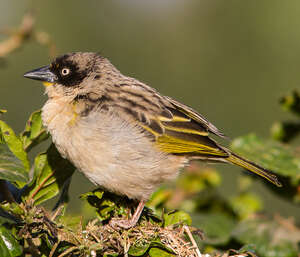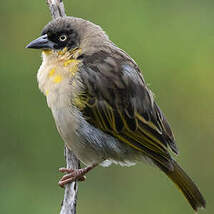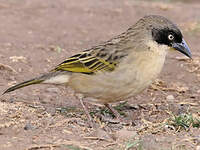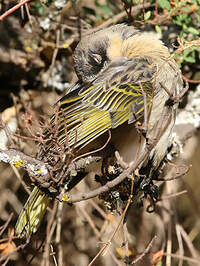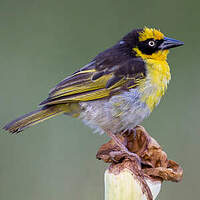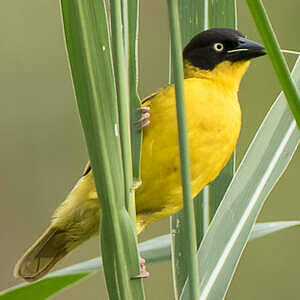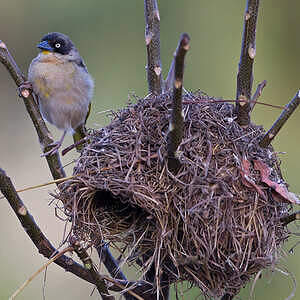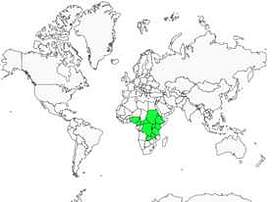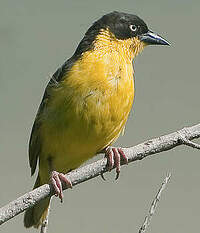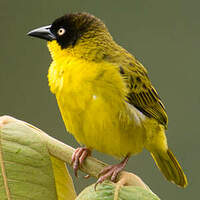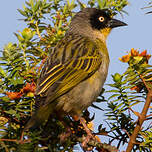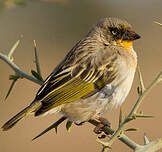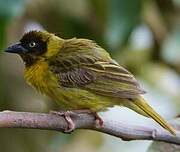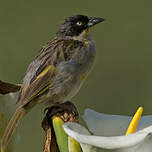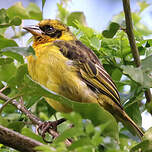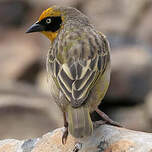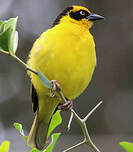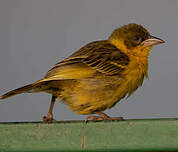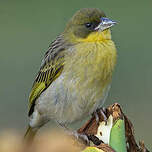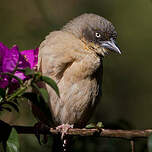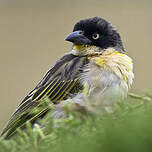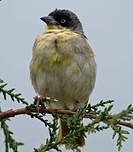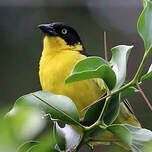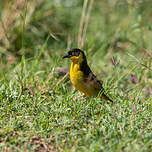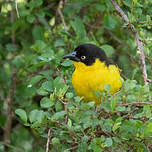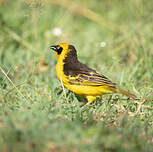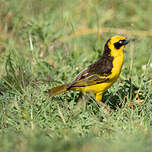Baglafecht Weaver
Ploceus baglafecht - Tisserin baglafecht
Identification
The Baglafecht Weaver, which belongs to the Ploceidae family, is a large-sized weaver that has the widest variation of plumage out of all weaver species. Regardless of the subspecies and sex, they all have a pale eye, a face that is more or less tinged with black, a yellow or beige-gray breast, and yellow or green wing borders. The nominative subspecies P.b. baglafecht is the only one with nuptial plumage in the male. From the front, the reproductive male has a black mask between the top and bottom of the golden yellow head. The nape and sides of the nape are grayish-green. The upper parts are olive-tinged and brown-spotted. The remiges and rectrices are brown bordered with yellow. The breast is yellow, and the belly is whitish-gray. The female resembles the male but the crown is greenish and she has a dull black mask. The upper parts of P.b. neumanni are a brighter green than the nominative subspecies, and the yellow forehead is a bit paler. P.b. eremobius is slightly smaller than the nominative subspecies and the plumage is identical but with more whiteness to the lower parts. P.b. emini has the forehead, crown top, chin, throat, and breast golden yellow that all surrounds the common black mask of all subspecies. The rest of the body is brown-olive. The flanks can be slightly yellow, the mantle is speckled more or less, and the remiges are bordered with pale yellow. The female, identical to the male, has the black crown. The black crown of P.b. stuhlmanni blends into the black mask and the female has a duller crown. In both sexes, the nape and upper parts are yellowish-green. The male P.b. reichenowi has the crown top, the back of the ear-coverts, the chin, and the throat a golden yellow that is all surrounded by the common black mask.The back of the head and the nape are black. It has a large black mask around the eyes, descending slightly on the cheeks. The underside is entirely golden yellow and the top is entirely black. Only the yellow wing edgings, contrasting with the rest of the upper parts, bring colour to the bird seen from behind. The female has the head entirely black except for the throat and the sides of the nape which are golden yellow. Like the male, she has the upper parts black and the lower parts yellow. P.b. sharpii resembles P.b. stuhlmanni with the male's upper parts greener and the lower parts pale yellow, P.b. nyikae has the crown dark and the upper parts greyish. In all the subspecies, the beak is black, strong and pointed. The legs are flesh-coloured. The juveniles are duller than the females with dark eyes.
Subspecific information 8 subspecies
- Ploceus baglafecht baglafecht (Eritrea and Ethiopia)
- Ploceus baglafecht neumanni (e Nigeria, Cameroon and Central African Republic)
- Ploceus baglafecht eremobius (sw Sudan and ne DRCongo)
- Ploceus baglafecht emini (se Sudan, sw Ethiopia and n Uganda)
- Ploceus baglafecht reichenowi (e Uganda, Kenya and n Tanzania)
- Ploceus baglafecht stuhlmanni (e DRCongo and s Uganda to w Tanzania)
- Ploceus baglafecht sharpii (s and sw Tanzania)
- Ploceus baglafecht nyikae (ne Zambia and n Malawi)
Foreign names
- Tisserin baglafecht,
- Tejedor baglafecht,
- tecelão-de-garganta-amarela,
- Baglafechtweber,
- Baglafechtwever,
- Tessitore baglafecht,
- baglafechtvävare,
- Bergvever,
- pletiarka baglafecht,
- snovač černolící,
- Baglafecht’ Væver,
- ylänkökutoja,
- teixidor de Baglafecht,
- wikłacz złotoczelny,
- Черноухий ткач,
- ミミグロハタオリ,
- 黄腹织雀,
- baglafechtvävare,
- 黃腹織布鳥,
Voice song and call
Habitat
The Baglafecht Weaver is mainly found at medium to high altitudes, ranging from 800 to 3,000 metres, in wooded areas where it can find clearings with or without brushwood, and preferably wet environments. Outside of forests it can easily live in villages and gardens as long as it has an open environment, among fields and at the edge of forests.
Behaviour character trait
The Baglafecht Weaver lives in pairs or small groups, but never reaches the numbers of other species of weavers like the Gendarme Weaver or the African Golden Weaver during nesting time. It looks for its food in the trees, probing the layers of leaves to dislodge insects. It isn't uncommon to see it plunge its beak into the middle of flowers to swallow a few drops of nectar.
Dietfeeding habits
Reproduction nesting
The breeding season in Africa lasts all year, however the period varies from country to country - it is generally from March to December. The Baglafecht Weaver is a solitary and monogamous nester. It vigorously defends its territory, although two pairs may sometimes be observed nesting in the same area. It is the male who is in charge of constructing the nest - the female can choose the site. The nest is usually placed between 2 and 10 metres, but usually between 3 and 6 metres, from the ground, and is made of tightly woven grass strips secured to branches, woven into banana leaves or beneath palm leaves.
Typically the tree of choice is an acacia, but very rarely an eucalyptus, which will not be stripped but will provide protection to the clutch. The nest is oval in shape with thick walls and flattened underside. It is constructed coarsely, without an entrance tunnel leading into the nest like that of other Ploceidae. There is just a simple opening on one side with a small projection inside so to keep the eggs and chicks from falling out and a slight overflow like a small porch. The insides of the nest are then lined by both sexes with feathers, down and plant matter. The male may make other nests on the territory, but only one will be used. The female will lay 1 - 3 eggs which she will incubate alone for about two weeks. The male will stay nearby perched on one of the other nests he had constructed and sing. The eggs are uniformly covered in brown-red spots, bluish-green or white - plain. The female alone will begin to feed the chicks from the fourth day, when the male joins her to feed the young.They will be fed insects over a period spanning from 15 to 17 days. Not many predators of the Baglafecht Weaver's nests are known, although monkeys have been seen raiding the nests.Geographic range
P.b. Baglafecht Weaver is present in Eritrea and in the highlands of Ethiopia. P.b. neumanni is present in West Africa, in Nigeria, Cameroon and in Central African Republic. P.b. eremobius is present in Sudan and in Democratic Republic of Congo. P.b. emini is present in Sudan, Ethiopia and Uganda. P.b. stuhlmanni is present in Democratic Republic of Congo, Uganda, Rwanda, Burundi and Tanzania. P.b. reichenowi is present in Uganda, Kenya and Tanzania. P.b. sharpii is present in Tanzania. P.b. nyikae is present on the Nyika Plateau in Zambia and in Malawi.
Threats - protection
Sources of information
- IOC World Bird List (v15.1), Gill, F and D Donsker (Eds). 2025-12-07.
- Birds of the Horn of Africa, Nigel Redman
- Birds of East Africa: Kenya, Tanzania, Uganda, Rwanda, Burundi, Terry Stevenson, John Fanshawe
- Hanbook of the birds of the world - Vol 15, del Hoyo J., Elliott A. Christie D.
- eBird, Cornell Lab of Ornithology et National Audubon Society
- Birds of the World, The Cornell Lab of Ornithology
- Biodiversity explorer The web of life in Southern Africa,
Other sources of interest
 Specification sheet created on
17/07/2023 by Nathalie Santa Maria
Specification sheet created on
17/07/2023 by Nathalie Santa MariaTranslation by AI Oiseaux.net
© 1996-2026 Oiseaux.net
- Accipitriformes
- Aegotheliformes
- Anseriformes
- Apodiformes
- Apterygiformes
- Bucerotiformes
- Caprimulgiformes
- Cariamiformes
- Casuariiformes
- Charadriiformes
- Ciconiiformes
- Coliiformes
- Columbiformes
- Coraciiformes
- Cuculiformes
- Eurypygiformes
- Falconiformes
- Galliformes
- Gaviiformes
- Gruiformes
- Leptosomiformes
- Mesitornithiformes
- Musophagiformes
- Nyctibiiformes
- Opisthocomiformes
- Otidiformes
- Passeriformes
- Pelecaniformes
- Phaethontiformes
- Phoenicopteriformes
- Piciformes
- Podargiformes
- Podicipediformes
- Procellariiformes
- Psittaciformes
- Pterocliformes
- Rheiformes
- Sphenisciformes
- Steatornithiformes
- Strigiformes
- Struthioniformes
- Suliformes
- Tinamiformes
- Trogoniformes

